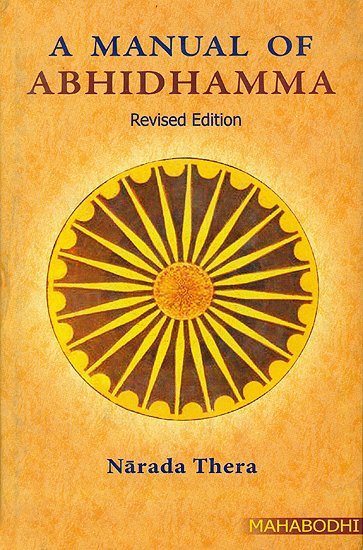A Manual of Abhidhamma
by Nārada Thera | 80,494 words | ISBN-13: 9789380336510
In the Abhidhammattha Sangaha there is a brief exposition of the Law of Dependent Origination, followed by a descriptive account of the Causal Relations that finds no parallel in any other philosophy. Edited in the original Pali Text with English Translation and Explanatory Notes by Narada Maha Thera....
§ 17.
- Akusalesu pana lobhamūlesu tāva patha me asankhārike aññasamānā terasa cetasikā akusalasādhāranā cattāro c'āti sattarasa lobhaditthīhi saddhim ekunavīsati dhammā sangaham gacchanti.
- Tath'eva dutiye asankhārike lobhamānena.
- Tatiye tath'eva pītivajjitā lobha-ditthīhī saha atthārasa.
- Catutthe tath'eva lobha-mānena.
- Pañcame patighasampayutte asankhārike doso issā macchariyam kukkuccañc'āti catūhi saddhim pītivajjitā te eva vīsati dhammā sangayhanti. Issā-macchariya-kukkuccāni pan'ettha paccekam'eva yojetabbāni.
- Sasankhārikapañcake' pi tath'eva thīnamiddhena visesetvā yojetabbā.
- Chanda-pītivajjitā pana aññasamānā ekādasa akusalasādhāranā cattāro c'ātpannarasa dhammā uddhaccasahagate sampayujjanti.
- Vicikicchāsahagatacitte ca adhimokkha virahitā vicikicchā sahagatā tath'eva panna rasadhammā samupalabbhantī' ti sabbathā pi dvādasā-kusala-cittuppādesu paccekam yojiyamānā' pi gananavasena sattadhā'va sangahitā bhavantī'ti .
§ 18.
Ekūnavīsatthārasa - vīsekavīsa vīsati
Dvāvīsa pannarase'ti - sattadhā kusale thitā
Sādhāranā ca cattāro - samānā ca dasā pare.
Cuddasete pavuccanti - sabbākusalayogino.
(translation)
§ 17.
- Now, in immoral consciousness, to begin with, in the first unprompted consciousness[1] nineteen mental states enter into combination - namely, thirteen unmoral concomitants, the four common immoral concomitants, making seventeen, together with attachment and misbelief. (13 + 4 + 2 = 19)
- Similarly in the second unprompted consciousness[2] the same seventeen, together with attachment and conceit. (13 + 4 + 2 = 19)
- Similarly in the third unprompted consciousness there are eighteen concomitants, together with attachment and misbelief but excluding joy.[3] (12 + 4 + 2 = 18)
- Similarly in the fourth (there are eighteen) with attachment and conceit. (12 + 4 + 2 = 18)
- In the fifth unprompted consciousness connected with aversion the above twenty concomitants, excluding joy,[4] are combined together with hatred, jealousy, avarice and worry. Of them jealousy, avarice and worry should be combined separately.[5] (12 + 4 + 4 = 20)
- In the five types[6] of prompted consciousness the above concomitants should similarly be combined with this difference that sloth and torpor are included. (21; 21; 20; 20; 22).
- In the type of consciousness connected with restlessness fifteen mental states occur - namely, eleven aññasamānas excluding conation[7] and joy, and the four immoral Universals. (11 + 4 = 15)
- In the type of consciousness connected with perplexity fifteen states are similarly obtained together with perplexity, but devoid of decision.[8] (10 + 4 + 1 = 15)
Thus in all the twelve types of immoral consciousness synthesis becomes sevenfold when reckoned according to their different combinations.[9]
§ 18.
Nineteen, eighteen, twenty, twenty-one, twenty, twenty-two, fifteen, - thus they stand in seven ways in the immoral consciousness.
Those fourteen mental states - namely, the four immoral universals, and ten unmorals,[10] are said to be associated with all the immoral types of consciousness.
Footnotes and references:
[1]:
i.e., Somanassa sakagata ditthigata sampayutta asankhārika citta - Unprompted consciousness, accompanied by pleasure, connected with misbelief.
[2]:
i.e., the unprompted consciousness not connected with misbelief. Conceit and misbelief do not coexist.
[3]:
i.e.. the unprompted consciousness accompanied by upekkhā. Joy does not coexist with indifference.
[4]:
Joy does not coexist with aversion and grief.
[5]:
Being unfixed mental adjuncts (aniyatayogino). Their objects differ and they arise severally.
[6]:
They are the four types of prompted consciousness rooted in attachment and the one rooted in aversion. Sloth and torpor are present only in the immoral prompted consciousness.
[7]:
There is no chanda, the will-to-do, as restlessness is predominant here.
[8]:
Adhimokkha, the mental factor that dominates in deciding cannot exist in a perplexed mind.
[9]:
(i) 1st and 2nd asankhārika citta = 19; (ii) 3rd and 4th asankhārika citta = 18; (iii) 5th asankhārika citta = 20; (iv) 1st and 2nd sasanhhārika citta = 21; (v) 3rd and 4th sasankhārika citta = 20; (vi) 5th sasankhārika citta = 22; (vii) moha citta = 15. Thus they divide themselves into seven classes according to numbering.
[10]:
i.e., excluding chanda, pīti, and adhimokha from the 13 aññasamānas.
